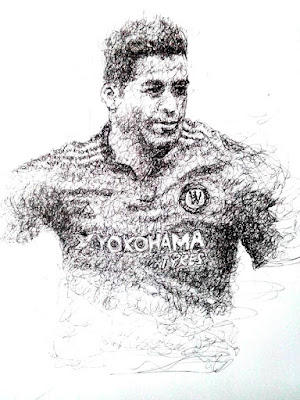Tips on Pencil Portrait Drawing - The Eyes
As with all features of the human face, it is important that we do not draw the preconceived ideas we have about eyes. The eyes are the windows to a person's soul and reflect much of the emotionality and personality of that person. Therefore, they must be drawn exactly how they are.
There is much to be said about the different parts of the eye, but here are a few guidelines that will get you started in the right direction:
* Complexity
Like the ears, eyes are rather complex forms and therefore we need to be patient and spend the necessary time to draw them as realistic as we can. Here are the important parts of the eye:
- The surrounding bone structure
- The eyebrows
- The eyelids
- The eyelashes
- The eyeball
- The iris
- The pupil
* Eye Structure
The eyeball sits deep inside the eye socket. The eye socket has a protruding rim at the top on which the eyebrow is situated. You can trace your finger all around the eye socket and get a good idea of its shape. It is within this rather rectangular shape that we will draw the eye.
* Eyeball
The eyeball has a rather large spherical shape. In front there is a protruding egg shaped bulge where the lens is located. The eyelids are stretched over the eyeball.
For drawing purposes we are interested in that part of the eyeball that we usually refer to as "the whites" of our eyes. Now, those whites are in general not white at all but have shadows on them which, at times, can be quite dark. Remember also that the whites are part of a spherical surface. So when shading the whites, we should think of the elements of shading that are applicable to a sphere.
* Eyelids
The eyelids are stretched over the eyeball. Therefore, the curvature of the eyeball gives the eyelids their shape. This is something to understand and memorize.
It is important to capture the exact shape of the eyelid lines and to recognize that they follow the curvature of the eyeball. Also, when the upper eyelid is retracted, it leaves a clearly visible crease which must also be rendered accurately.
Finally, notice the peculiar little shape in the inside corner of the eye where the upper and lower eyelids join. Be sure to draw this corner as observed in your particular subject.
* Eyelashes
The eyelashes sprout from the eyelids. They grow in clumps and should be rendered that way. Spend some time observing how eyelids grow and are directed. Notice that very often the lashes on the upper eyelid are much larger than those on the lower lid. Eyelashes belonging to a particular clump are frequently entangled. The eyelashes are usually drawn at the very end.
* The Iris
The iris is the circle of color in the middle of the eye. It is crucial for a good likeness that the value of the color is rendering correctly. A dark brown or a pale blue, for example, will appear very smooth and even. Green and deep blue irises, on the other hand, will have the most design and contrast in it.
* The Pupil
The pupil is situated exactly in the middle of the iris. As is the case with the iris, the pupil is an exact circle (if a frontal view) and is always black.
Very often there is a circular highlight situated just where the iris and pupil meet. This highlight adds quite a bit of life to the portrait. Look for it and add it to your drawing.
* Eyebrows
The eyebrows play a very important part in the appearance of a person. They also have a lot to do with the expression on the person's face. They follow the shape of the upper rim of the bone structure in which the eye is placed.
* Placement
The distance between the two eyes is on average exactly equal to one eye-width. Drawing a vertical line from the inside corner of the eye down to the nose should touch the outside of the nostril. Of course, these are average values and there are individual differences.
It is important to get a good impression of the shape, angle, width, and exact location of the eyebrows. Carefully observe the direction of the hairs and how they are intertwined.
Much can still be said about drawing eyes. For example, we could talk about the differences between the eyes of men, women, and children. Or, we could talk about capturing expressions of anger, laughter, or sadness, and much more. But the above guidelines will give you a good start. Later, you may want to undertake a more thorough study of the eye and how to draw it.
Remi Engels is a pencil portrait artist and oil painter and expert teacher. Check out his Pencil Portrait Course and his Portrait Print Package Special
Article Source: http://EzineArticles.com/?expert=Remi_Engels

